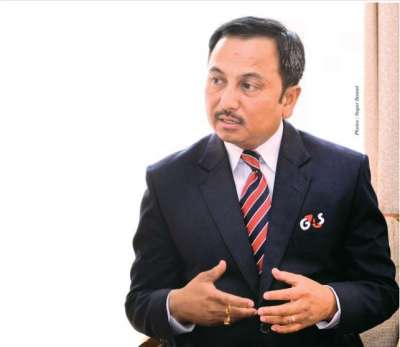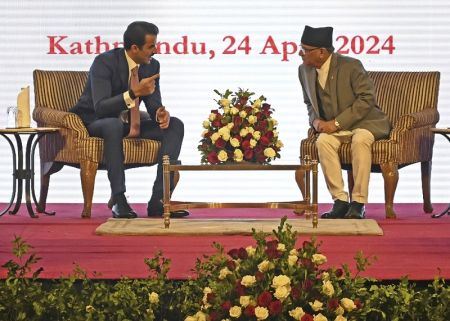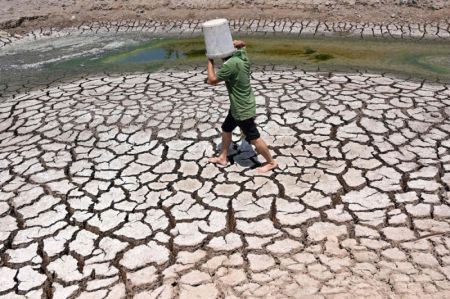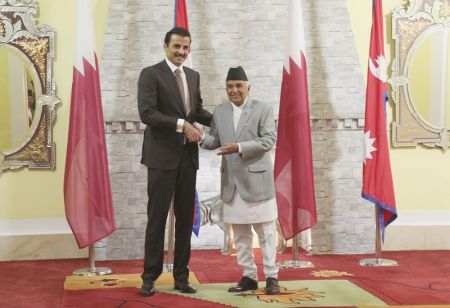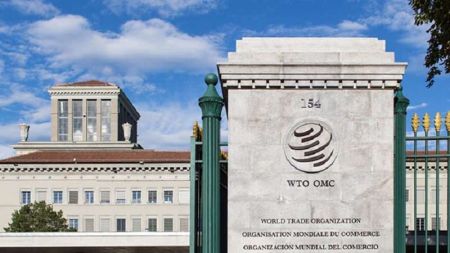
Nepal Country Director
Kenichi Yokoyama
Asian Development Bank
‘We have been actively involved in the energy sector’
Kenichi Yokoyama is Nepal Country Director for the Asian Development Bank (ADB), a Manila-based multilateral development finance institution dedicated to alleviating poverty in Asia and the Pacific. Yokoyama was serving as the principal water resources specialist at ADB´s South Asia department before he assumed current responsibilities on March 26, 2012. In an interview with New Business Age, Yokoyama sheds light on the ADB-funded projects in the water, energy, agriculture and other sectors in Nepal. Excerpts:
Melamchi, the ADB-financed water supply project, is in a new controversy now after the Chinese contractor left the work. How will the project move ahead now?
ADB is committed to supporting the construction of the Melamchi tunnel work, the water treatment plant and the distribution system. With a population of around three million, the Kathmandu Valley has been facing an acute water shortage. This is a huge developmental constraint. We have been facilitating the Nepal government in the completion of the tunnel and other works on time.
It is unfortunate that the Chinese contractor had to leave the project because of some issues related to work progress. Now, we are supporting the government to go for immediate rebidding. The government is looking for first class contractors. Such contractors from China, Korea, India, France and other European countries have shown interest in the project. We hope that the government will be able to hire a new contractor by March 2013 and complete the project by March 2016.
But this has increased the cost of the project and delayed it further. Will the project complete within the new deadline?
The topmost priority for the government is to identify a qualified contractor with high experience in similar tunnel works. Although there are concerns about the cost, we have to think about the seriousness of the water shortage problem in Kathmandu which calls for urgent attention. We have to ensure that the Melamchi project is completed on time.
Despite the many ups and downs seen over the almost past seven years, ADB remains associated with the project. The only reason for this association is that we feel that Melamchi is an important project. We have been holding regular discussions with the Ministry of Urban Development on the specific actions to be taken to take the project forward, including the swift selection of an internationally reputed, committed, dedicated and efficient contractor who can build a high quality infrastructure. Given the importance of the Melamchi project in addressing the water demand of the 2.6 million people living in the Kathmandu Valley, ADB remains fully committed to providing the necessary support to the Government of Nepal to complete the project by early 2016 or earlier.
ADB’s recent fund for water projects in Nepal is said to be aimed at improving irrigation and prevent water-induced disasters. How is it different from other water projects?
These projects aim to bring about higher rural livelihood. The government is seeking support for rapid agricultural transformation. In that context, we are supporting irrigation and water disaster mitigation risk management projects. We are building on the achievements made thus far. In irrigation, Nepal has comparative advantage in having irrigation systems managed by farmers. Building on this, ADB is supporting agriculture development for making it more profitable and commercial so that the farmers can increase their income.
Nowadays, effective water management is a critical challenge for many countries. Particularly in the dry season, many countries are facing a shortage of water supply. Nepal, too, needs an effective water management system. The country ought to fulfill additional industrial needs while protecting the conventional water users. An efficient and equitable distribution of irrigation water is also pretty much needed to increase the farmers’ income.
Once again, ADB recently listed the West Seti Project among the newly proposed ones. How do you want to participate in this project?
It’s not the West Seti, but the Upper Seti project, located in Tanahun district, that ADB is supporting. Actually, we are submitting a proposal for this project to the ADB Board early next year. The name of the project is Tanahu Hydropower Project. It is a 140MW storage project. It could help address the power shortage of not only Kathmandu but the country as a whole.
ABD seems to have planned to involve itself quite heavily in the energy sector through new projects like Tanahu hydro and continue with other ongoing energy sector programs. What is the strategy?
Our assistance strategy is to support the government to address the most critical development constraints including infrastructure, its management system, and delivery of effective public service to the needy people including the poorest. Addressing the critical infrastructure bottlenecks is of high priority. The country is facing acute power shortage. Electricity is available only six hours a day in the dry season. How can industries come to Nepal and operate in such a situation? ADB has been actively involved in the energy sector with previous assistance in Kali Gandaki A and Khimti Hydropower projects, which account for some 30 percent of the country’s generation capacity at the moment. The Tanahu project, which is a storage project, will add additional 140 MWand can provide a stable power supply during the dry season.
We will support the efficient implementation of the Tanahu Hydro Project. There are two other ongoing projects in transmission and distribution, respectively. We are also supporting NEA in its institutional reforms which includes enhancing its financial position by increasing tariff, reducing distribution loss and providing electricity to private industries and local stakeholders more efficiently.
Many ADB-supported projects – mainly those in the agriculture sector - are discontinued after the completion of the first phase. Why?
Our programs are aimed at demonstrating how development can be pursued most effectively. For example, there was a community ground water project where a community ground water group was set up and provided with shallow tube-well systems. The beneficiaries can now do triple cropping with tube-well irrigation with proper maintenance of the tube-wells, which they are able to manage. Likewise, projects such as community irrigation and commercial agriculture are helping establish sustainable development systems. The government can replicate similar projects.
It is said that $ 15.3 million that ADB had allocated for various projects such as commercial agriculture, community irrigation, skill development programs, etc, could not be used. What is the reality?
The projects need to follow a specific timeline. There are also cases where the actual cost of implementation is lower than the initial projection. For example, in one of the strategic road projects, the bidding price was lower than the estimated price, thanks to the competition and devaluation of the Nepali Rupee, resulting in substantial savings. In the irrigation sector, too, the project cost is often lower than the estimated cost because of competitive bidding. There are some cases where the project implementing agency has limited absorptive capacity. Overall, we have identified $15 million savings this year, but we are also discussing with the government that these savings could be used for other projects in Nepal, such as additional financing requirement of the Melamchi project.
What would be your investment portfolio for the next couple of years for Nepal? Will it increase?
The allocation of the Asian Development Fund (ADF) is decided biannually, and the amount for the year 2013 -14 is to be finalized at the end of this year. At this moment, we expect it to be at least about $ 250 million per annum.
Could you please highlight ADB’s present development assistance priorities for Nepal?
The thrust of ADB’s ongoing country partnership strategy for Nepal (2010-2013) is to help sustain the hard-won gains of the country’s peace process by promoting broad-based inclusive economic growth, inclusive social development, governance and capacity building, as well as climate change adaptation and environmental sustainability.
ADB’s assistance supports Nepal in different sectors such as agriculture and natural resources, education, water supply and other municipal infrastructures and services, transport, information and communication technology and finance and energy. We support these operations through the promotion of gender equality and social inclusion, regional cooperation and integration, public private partnerships, along with greater engagement of the civil society and NGOs.
Our new country partnership strategy for Nepal is being formulated in consultation with the Nepal Government. ADB’s support will focus on addressing the country’s development constraints including energy, transport, urban and rural infrastructures and skill development. To support these priorities, ADB will also promote governance, private sector development, regional integration, gender and social inclusion and climate change adaption.
Could you please briefly describe ADB’s assistance in the agriculture sector?
ADB has been Nepal’s main development partner in agriculture. Agriculture remains the largest component of ADB’s assistance to Nepal. ADB has supported in increasing the production of crops and livestock, raising agricultural income and creating employment opportunities for rural people. ADB’s assistance to Nepal includes support for agricultural credit, small farmer development, livestock, irrigation, agricultural roads, forestry, and crop diversification. ADB is also supporting the government’s preparation for the Agriculture Development Strategy that will set out the long-term vision and strategy for the agriculture sector for the next 20 years, and priority programs for the next 10 years.
What is the recent development in ADB’s funding for the transport sector?
We have been supporting the construction of strategic roads network. Similarly, we are supporting the Sub-regional Transport Enhancement Project which was approved in 2010. All contracts have been signed for this project and the work progress is about 30 per cent. A new transport project of about $100 million is envisaged for 2013. We are also planning another project based on a new lending modality called the multi-tranche financing facility for 2014 for the transport sector. The idea is to provide a long-term financing framework of $200- 250 million, based on which individual sub- loans will be launched.
ADB is preparing to provide support for setting up a new CTEVT- like structure under the Ministry of Education. Would you please highlight the program?
ADB is not providing assistance to a new CTEVT- like structure under the Ministry of Education. However, ADB will support the Government of Nepal, through the proposed Skills Development Project to develop a market responsive and social- and gender-responsive Technical Education and Vocational Training (TEVT) by assisting the implementation of policy, institutional and operational reforms, delivery of demand-oriented skills training, short-term market oriented skills training focusing on excluded groups, and effective project management and monitoring and evaluation.
For the last few years, ADB, DFID and WB had started to implement synchronized programs to avoid duplication. Why have you abandoned this practice now?
We have been continuously working together with the World Bank, DFID and JICA, who are our co-members in the Nepal Portfolio Performance Review process. The government is taking the lead, and a meeting is held annually to discuss and resolve issues to enhance project implementation performance. Issues like public finance, management, procurement, human resource management and management of the development regions. These issues are critically influencing the implementation of the developmental projects. Implementation of the concept of e-bidding for infrastructure works is almost complete. This allows bidders to submit their bids through internet. This can substantially enhance the transparency and efficiency of the bidding process.
For new development programs, a close coordination and collaboration among the development partners is maintained as an established practice in project preparation and appraisal, to avoid any duplication. Efforts are also being made to develop a common sector roadmap or result framework and define programs within the framework and pursuing the possibility of co-financing as much as possible.
Despite great donor involvement in programs like the School Sector Reform, the achievement has been negligible, mainly converting government schools into community-run ones. What is the reason?
In the school sector, we have to take into account that we have started from a very low base. Nepal has significant challenges such as difficult geography and remoteness in the mountain region. I don’t agree that the achievement has been negligible. If you look at the statistics, primary school enrollment was barely 60 percent in 1990; it is 95 percent now - a significant change brought about by education programs. However, it is also true that some significant challenges still remain, such as the quality of education and a high percentage of dropout. Prudent financial management of the education development fund, too, is an issue. Building on the progress made, I believe these constraints can also be addressed gradually. We have a donor co-ordination mechanism, which enables all the donors to work together to make the most efficient progress by avoiding duplication.
ADB has supported to modernize Nepal’s capital market. What are the latest developments in this regard?
ADB is supporting Nepal’s efforts to develop the capital and bond markets to attract and promote private investment. For this, we have an ongoing Capital Markets and Infrastructure Capacity Support Project. Under the project, a team of consultants is being selected. There are two components of this project. The first is to support the capital market development, particularly the bond market. The second one aims to develop an enabling environment for public private partnership (PPP), identify investors, design and carry out feasibility studies. We hope to mobilize the consultants by early 2013.
We are also discussing with the Government of Nepal the opportunity for ADB to issue local currency bonds that will help provide long-term financing for private infrastructure investment and also help develop the country’s bond market.
How do you view the progress of ADB’s projects in Nepal?
The country assistance program evaluation (CAPE) conducted by ADB’s Operations Evaluation Department a few years back found that overall, ADB’s lending program had a positive impact socially, environmentally and economically. These projects have helped reduce not only poverty but also gender disparity and social exclusion by benefiting the poor.
Some of ADB’s programs are directly targeted at the poor and some are indirectly targeted, but the ultimate objective is poverty reduction. Results can be seen from the assistance that ADB has been providing over the years. For instance, the transport system in the country has greatly improved — the main strategic road network as well as the rural roads connecting the remote parts of the country. This has helped improve public service delivery and livelihoods in these areas. ADB’s assistance has also contributed in improving the living standards of the rural communities through the provision of improved water supply and sanitation facilities. However, we recognize that the assistance we provide needs to be more effective in terms of reaching the poor and vulnerable and sustaining these development benefits.
How have you viewed Nepal’s inability to bring about a full-fledged budget at the beginning of the fiscal year? How has it affected your support?
Although the government could not bring a full budget, a one-third interim budget was provided. We are working with the government so that the developmental activities are least affected in the given context. As far as the ongoing projects supported by ADB and other donors are concerned, the ordinance (budget) has a special provision to allow the government to provide enough funds through budgetary reallocation. Nevertheless, we remain concerned how the necessary funds would be allocated in a smooth and timely manner for efficient project implementation under the present circumstance.
What are the challenges facing the development projects in Nepal?
In general, projects in Nepal face the challenge of timely implementation due to the country’s difficult topography and remoteness of many districts. Poor infrastructures and limited human resource capacities are the other challenges. In some cases, implementation of the projects has been affected by local strikes as well.
The political transition process has been slow and is still fraught with risks and challenges for development activities. In particular, the absence of elected local bodies since July 2002 has been a major impediment to governance, service delivery, and development works at the local level.
In addition, labour unrest in the fragile political environment, coupled with acute power shortage, has constrained the revival of key sectors of the economy and private investments. Thus, improving basic infrastructure and strengthening governance and public and market institutions is very crucial for Nepal.
Despite these challenges, the performance of ADB’s project portfolio has improved. This also demonstrates the hard efforts by the government agencies that implement the ADB-financed projects. While the overall performance still remains below ADB’s wide average, I am hopeful that this progressive improvement will continue under the strong partnership with ADB.
How do you view the current economic situation of Nepal?
Despite the difficult political environment and the global economic slowdown, Nepal has been able to preserve a reasonable macroeconomic stability with a moderate and steady economic growth. We are pleased to note that the government’s and Nepal Rastra Bank’s proactive policy measures on the vulnerability of the banking sector and rising inflation have eased the problems in recent months, although the risks remain. The external position, too, has remained stable with the widening trade deficit being offset by sustained increase in remittance inflows and tourism receipts. However, exports continue to be sluggish due to the long-term structural weaknesses in the economy. Although agricultural growth could slow down in FY 2013 because of the late monsoon and shortage of chemical fertilizers, we believe that Nepal will be able to maintain a moderate growth supported by the service sector.


